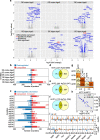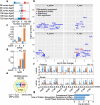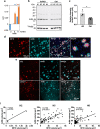A proteomics analysis of 5xFAD mouse brain regions reveals the lysosome-associated protein Arl8b as a candidate biomarker for Alzheimer's disease
- PMID: 37468900
- PMCID: PMC10357615
- DOI: 10.1186/s13073-023-01206-2
A proteomics analysis of 5xFAD mouse brain regions reveals the lysosome-associated protein Arl8b as a candidate biomarker for Alzheimer's disease
Abstract
Background: Alzheimer's disease (AD) is characterized by the intra- and extracellular accumulation of amyloid-β (Aβ) peptides. How Aβ aggregates perturb the proteome in brains of patients and AD transgenic mouse models, remains largely unclear. State-of-the-art mass spectrometry (MS) methods can comprehensively detect proteomic alterations, providing relevant insights unobtainable with transcriptomics investigations. Analyses of the relationship between progressive Aβ aggregation and protein abundance changes in brains of 5xFAD transgenic mice have not been reported previously.
Methods: We quantified progressive Aβ aggregation in hippocampus and cortex of 5xFAD mice and controls with immunohistochemistry and membrane filter assays. Protein changes in different mouse tissues were analyzed by MS-based proteomics using label-free quantification; resulting MS data were processed using an established pipeline. Results were contrasted with existing proteomic data sets from postmortem AD patient brains. Finally, abundance changes in the candidate marker Arl8b were validated in cerebrospinal fluid (CSF) from AD patients and controls using ELISAs.
Results: Experiments revealed faster accumulation of Aβ42 peptides in hippocampus than in cortex of 5xFAD mice, with more protein abundance changes in hippocampus, indicating that Aβ42 aggregate deposition is associated with brain region-specific proteome perturbations. Generating time-resolved data sets, we defined Aβ aggregate-correlated and anticorrelated proteome changes, a fraction of which was conserved in postmortem AD patient brain tissue, suggesting that proteome changes in 5xFAD mice mimic disease-relevant changes in human AD. We detected a positive correlation between Aβ42 aggregate deposition in the hippocampus of 5xFAD mice and the abundance of the lysosome-associated small GTPase Arl8b, which accumulated together with axonal lysosomal membranes in close proximity of extracellular Aβ plaques in 5xFAD brains. Abnormal aggregation of Arl8b was observed in human AD brain tissue. Arl8b protein levels were significantly increased in CSF of AD patients.
Conclusions: We report a comprehensive biochemical and proteomic investigation of hippocampal and cortical brain tissue derived from 5xFAD transgenic mice, providing a valuable resource to the neuroscientific community. We identified Arl8b, with significant abundance changes in 5xFAD and AD patient brains. Arl8b might enable the measurement of progressive lysosome accumulation in AD patients and have clinical utility as a candidate biomarker.
Keywords: 5xFAD; Aggregation; Alzheimer’s disease; Amyloid-β Amyloidogenesis; Arl8b; Biomarker; Proteomics.
© 2023. The Author(s).
Conflict of interest statement
LMB reports personal fees from Hoffman La Roche Ltd, Remix Therapeutics, Annexon Biosciences, and Genentech. EJW reports personal fees from Hoffman La Roche Ltd, Triplet Therapeutics, PTC Therapeutics, Takeda, Teitur Trophics and Vico Therapeutics. All honoraria for these consultancies were paid through the offices of UCL Consultants Ltd., a wholly-owned subsidiary of University College London. The mentioned commercial entities have not participated in the design, performance, evaluation, or writing of the study. The remaining authors declare that they have no competing interests.
Figures






Similar articles
-
Deep proteome profiling of the hippocampus in the 5XFAD mouse model reveals biological process alterations and a novel biomarker of Alzheimer's disease.Exp Mol Med. 2019 Nov 15;51(11):1-17. doi: 10.1038/s12276-019-0326-z. Exp Mol Med. 2019. PMID: 31727875 Free PMC article.
-
Quantitative proteomics of acutely-isolated mouse microglia identifies novel immune Alzheimer's disease-related proteins.Mol Neurodegener. 2018 Jun 28;13(1):34. doi: 10.1186/s13024-018-0266-4. Mol Neurodegener. 2018. PMID: 29954413 Free PMC article.
-
Fibrillar Aβ triggers microglial proteome alterations and dysfunction in Alzheimer mouse models.Elife. 2020 Jun 8;9:e54083. doi: 10.7554/eLife.54083. Elife. 2020. PMID: 32510331 Free PMC article.
-
Temporal and Sex-Linked Protein Expression Dynamics in a Familial Model of Alzheimer's Disease.Mol Cell Proteomics. 2022 Sep;21(9):100280. doi: 10.1016/j.mcpro.2022.100280. Epub 2022 Aug 6. Mol Cell Proteomics. 2022. PMID: 35944844 Free PMC article.
-
A compilation of reported alterations in the cerebrospinal fluid proteome in Alzheimer's disease.Brain Commun. 2025 May 23;7(3):fcaf202. doi: 10.1093/braincomms/fcaf202. eCollection 2025. Brain Commun. 2025. PMID: 40491829 Free PMC article. Review.
Cited by
-
Disruptions in axonal lysosome transport and its contribution to neurological disease.Curr Opin Cell Biol. 2024 Aug;89:102382. doi: 10.1016/j.ceb.2024.102382. Epub 2024 Jun 20. Curr Opin Cell Biol. 2024. PMID: 38905918 Free PMC article. Review.
-
Human-mouse proteomics reveals the shared pathways in Alzheimer's disease and delayed protein turnover in the amyloidome.bioRxiv [Preprint]. 2024 Oct 25:2024.10.25.620263. doi: 10.1101/2024.10.25.620263. bioRxiv. 2024. Update in: Nat Commun. 2025 Feb 11;16(1):1533. doi: 10.1038/s41467-025-56853-3. PMID: 39484428 Free PMC article. Updated. Preprint.
-
Transcriptional regulation by PHGDH drives amyloid pathology in Alzheimer's disease.Cell. 2025 Jun 26;188(13):3513-3529.e26. doi: 10.1016/j.cell.2025.03.045. Epub 2025 Apr 23. Cell. 2025. PMID: 40273909 Free PMC article.
-
Biological sex, microglial signaling pathways, and radiation exposure shape cortical proteomic profiles and behavior in mice.Brain Behav Immun Health. 2024 Nov 25;43:100911. doi: 10.1016/j.bbih.2024.100911. eCollection 2025 Feb. Brain Behav Immun Health. 2024. PMID: 39677060 Free PMC article.
-
Proteome-wide analysis identifies plasma immune regulators of amyloid-beta progression.Brain Behav Immun. 2024 Aug;120:604-619. doi: 10.1016/j.bbi.2024.07.002. Epub 2024 Jul 6. Brain Behav Immun. 2024. PMID: 38977137 Free PMC article.
References
-
- Theuns J, Van Broeckhoven C. Genes for Alzheimer dementia Acta neuropsychiatrica. 1999;11:60–62. - PubMed
Publication types
MeSH terms
Substances
Grants and funding
LinkOut - more resources
Full Text Sources
Medical
Molecular Biology Databases

